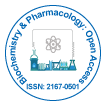
Biochemistry & Pharmacology: Open Access
Open Access
ISSN: 2167-0501

ISSN: 2167-0501
Opinion Article - (2025)Volume 14, Issue 1
The liver is the principal organ responsible for drug metabolism and detoxification, making it particularly susceptible to injury caused by xenobiotics, including pharmaceuticals. Drug-induced liver injury remains a major clinical challenge and a leading cause of acute liver failure, often necessitating drug withdrawal or dosage adjustments. The complexity of hepatic responses to pharmaceuticals has prompted a shift toward advanced investigative tools such as metabolomics — a high-throughput, comprehensive approach that captures global metabolic perturbations within biological systems. Metabolomic analysis, especially using mass spectrometry and nuclear magnetic resonance-based platforms, enables detailed profiling of small molecule metabolites, offering valuable insights into drug-induced hepatic stress, energy metabolism disruption, oxidative damage and other pathophysiological processes.
Many commonly prescribed pharmaceuticals, including acetaminophen, isoniazid, valproic acid, amiodarone and certain statins, have been implicated in hepatotoxicity, often through mechanisms that involve mitochondrial dysfunction, reactive metabolite formation, or immune-mediated responses. Acetaminophen, in particular, is well-documented for causing dose-dependent hepatic necrosis via the formation of the reactive intermediate N-acetyl-p-benzoquinone imine, which depletes glutathione and induces oxidative stress. Metabolomic profiling of acetaminophen-treated liver tissues reveals significant reductions in glutathione levels and alterations in amino acid metabolism, tricarboxylic acid cycle intermediates and lipid metabolites, reflecting extensive hepatocellular damage.
Isoniazid, used in tuberculosis treatment, undergoes hepatic biotransformation to form hydrazine and other toxic metabolites, contributing to liver inflammation and necrosis. Metabolomic analyses in both human and rodent models have revealed increased levels of bile acids and disruption in urea cycle metabolites, suggesting hepatic excretory dysfunction and nitrogen imbalance. Likewise, valproic acid, a widely used anticonvulsant, is known to inhibit fatty acid β-oxidation, leading to microvesicular steatosis and oxidative stress. Metabolomic studies in patients and experimental models demonstrate an accumulation of medium- and long-chain acylcarnitines and alterations in mitochondrial energy metabolism, consistent with impaired fatty acid utilization.
Another case involves amiodarone, a potent antiarrhythmic agent that causes hepatic steatosis and phospholipidosis. Metabolomic assessments show disrupted lipid metabolism, increased lysophosphatidylcholine levels and oxidative stress biomarkers. Similarly, statins such as atorvastatin and simvastatin, though generally well-tolerated, can occasionally trigger hepatotoxic reactions marked by elevated transaminases and, in rare cases, severe liver injury. Metabolomic fingerprints associated with statin-induced hepatotoxicity indicate perturbed cholesterol biosynthesis, oxidative damage and abnormal bile acid profiles, reflecting disrupted hepatobiliary homeostasis.
A key strength of metabolomic analysis lies in its ability to uncover early and subtle biochemical changes before the appearance of overt histopathological signs or clinical symptoms. By identifying specific biomarkers, such as altered levels of taurine, bile acids, sphingolipids and acylcarnitines, researchers can differentiate between adaptive and toxic responses, predict susceptibility to hepatotoxicity and stratify patient risk. This approach also aids in elucidating individual variability in drug metabolism, which may arise from genetic polymorphisms in cytochrome P450 enzymes, nutritional status, co-medications, or underlying liver diseases.
Additionally, metabolomics has proven valuable in investigating idiosyncratic drug reactions, which are unpredictable and not dose-dependent. For example, in the case of diclofenac-induced hepatotoxicity, metabolomic profiling has revealed disruptions in oxidative phosphorylation and increased production of reactive oxygen species. These insights have furthered the understanding of how mitochondrial impairment and immune activation contribute to rare but severe forms of liver injury.
Integration of metabolomics with other omics technologies such as transcriptomics, proteomics and genomics enhances mechanistic understanding and facilitates the development of predictive models for drug safety evaluation. Moreover, the application of metabolomics in preclinical drug screening and regulatory toxicology is gaining momentum, as it provides mechanistically relevant endpoints and supports evidence-based decision-making.
In conclusion, metabolomic analysis has emerged as a powerful tool for characterizing hepatotoxic responses induced by commonly prescribed pharmaceuticals. By capturing comprehensive metabolic alterations, it enables early detection, mechanistic elucidation and biomarker discovery related to drug-induced liver injury. The integration of metabolomic data into drug development pipelines and clinical monitoring protocols can significantly enhance patient safety and drug efficacy. As technology advances and databases expand, metabolomics will play an increasingly pivotal role in predictive toxicology and personalized medicine, particularly in identifying individuals at higher risk for adverse hepatic events. With continued interdisciplinary research, this approach holds promise for revolutionizing the assessment and management of pharmaceutical-induced hepatotoxicity.
Citation: Chia-Yun L (2025). Metabolomic Analysis of Hepatotoxic Responses Induced by Commonly Prescribed Pharmaceuticals. Biochem Pharmacol.14:390.
Received: 03-Feb-2025, Manuscript No. BCPC-25-37578 ; , Pre QC No. BCPC-25-37578 (PQ); Reviewed: 19-Feb-2025, QC No. BCPC-25-37578 ; Revised: 26-Feb-2025, Manuscript No. BCPC-25-37578 (R);; Published: 04-Mar-2025 , DOI: 10.35248/2167-0501.25.14.390
Copyright: © 2025 Chia-Yun L. This is an open-accessarticle distributed under the terms of the Creative Commons Attribution License, which permits unrestricted use, distribution, and reproduction in any medium, provided the original author and source are credited.